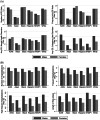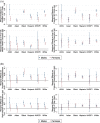Differential associations of homelessness with emergency department visits and hospitalizations by race, ethnicity, and gender
- PMID: 35593107
- PMCID: PMC9660436
- DOI: 10.1111/1475-6773.14009
Differential associations of homelessness with emergency department visits and hospitalizations by race, ethnicity, and gender
Abstract
Objective: To investigate the differential associations of homelessness with emergency department (ED) visits and hospitalizations by race, ethnicity, and gender.
Data sources: California Medicaid enrollment and claims.
Study design: We identified beneficiaries experiencing homelessness (BEH) and those who did not (NBEH) using diagnosis and place of service codes and residential addresses. Outcomes include four ED visit measures and four hospitalization measures. We compared the use of these services by BEH to NBEH overall and by race, ethnicity, and gender groups in regression models controlling for covariates.
Data collection: We used a sample of Medicaid beneficiaries who met eligibility criteria for a California Medicaid demonstration program in 2017 and 2018 but were not enrolled in the program. We identified 473,069 BEH, and the rest (1,948,422) were considered NBEH. We used the 2018 data for utilization analyses and most covariates. We constructed lagged measures of health conditions using 2017 data.
Principal findings: We found that homelessness was significantly associated with 0.34 more ED visits (p < 0.01) and a higher likelihood of frequent ED visits (2.77 percentage points [pp], p < 0.01), any ED visits due to mental health conditions (0.79 pp, p < 0.01), and any ED visits due to substance use disorders (1.47 pp, p < 0.01). Experiencing homelessness was also significantly associated with 0.03 more hospitalizations (p < 0.01), a higher likelihood of frequent hospitalizations (0.68 pp, p < 0.01) and high frequent hospitalizations (0.28 pp, p < 0.01), and a longer length of stay (0.53 days, p < 0.01). We found a larger association for American Indian and Alaska Native, Black, Native Hawaii or Pacific Islander, and White populations than that for Asian and Hispanic populations. The associations are larger for males than females.
Conclusions: Our findings identified distinct utilization patterns by race, ethnicity, and gender. They indicated the need for developing race, ethnicity, and gender-specific strategies to reduce ED visits and hospitalizations of BEH.
Keywords: emergency department visits; ethnicity; gender; health equity; homelessness; hospitalizations; race.
© 2022 The Authors. Health Services Research published by Wiley Periodicals LLC on behalf of Health Research and Educational Trust.
Figures



Similar articles
-
Associations of Homelessness With Primary Care and Acute Care Utilization Among Medicaid-Enrolled Youth.Med Care. 2024 Oct 1;62(10):631-638. doi: 10.1097/MLR.0000000000002009. Epub 2024 May 20. Med Care. 2024. PMID: 38775677
-
Substance Use, Homelessness, Mental Illness and Medicaid Coverage: A Set-up for High Emergency Department Utilization.West J Emerg Med. 2018 Nov;19(6):902-906. doi: 10.5811/westjem.2018.9.38954. Epub 2018 Oct 18. West J Emerg Med. 2018. PMID: 30429919 Free PMC article.
-
Emergency Department and Hospital Utilization Among Older Adults Before and After Identification of Elder Mistreatment.JAMA Netw Open. 2023 Feb 1;6(2):e2255853. doi: 10.1001/jamanetworkopen.2022.55853. JAMA Netw Open. 2023. PMID: 36787139 Free PMC article.
-
An incomplete picture: A scoping review of how scholars account for race and ethnicity in family homelessness research.J Community Psychol. 2025 Jan;53(1):e23148. doi: 10.1002/jcop.23148. Epub 2024 Sep 4. J Community Psychol. 2025. PMID: 39233470
-
Emergency Department Use, Hospitalization, and Their Sociodemographic Determinants among Patients with Substance-Related Disorders: A Worldwide Systematic Review and Meta-Analysis.Subst Use Misuse. 2023;58(3):331-345. doi: 10.1080/10826084.2022.2161313. Epub 2023 Jan 2. Subst Use Misuse. 2023. PMID: 36592043
Cited by
-
Factors influencing the length of hospital stay of people experiencing homelessness.Front Public Health. 2025 Mar 11;13:1545377. doi: 10.3389/fpubh.2025.1545377. eCollection 2025. Front Public Health. 2025. PMID: 40135152 Free PMC article.
-
A systematic narrative review of the research evidence of the impact of intersectionality on service engagement and help-seeking across different groups of women, trans women, and non-binary individuals experiencing homelessness and housing exclusion.PLoS One. 2025 Apr 24;20(4):e0321300. doi: 10.1371/journal.pone.0321300. eCollection 2025. PLoS One. 2025. PMID: 40273210 Free PMC article.
-
Characterizing suicidal ideation, suicidal behaviors, and service utilization among unhoused individuals using a health information exchange.J Clin Psychol. 2023 Nov;79(11):2542-2555. doi: 10.1002/jclp.23566. Epub 2023 Jul 11. J Clin Psychol. 2023. PMID: 37433045 Free PMC article.
-
Voices of the unhoused from Santa Fe, New Mexico: A mixed methods study of health status, substance use, and community harm reduction program perspectives.J Prev Interv Community. 2024 Jan-Mar;52(1):73-97. doi: 10.1080/10852352.2024.2352266. Epub 2024 May 17. J Prev Interv Community. 2024. PMID: 38757899 Free PMC article.
-
Easy to use and validated predictive models to identify beneficiaries experiencing homelessness in Medicaid administrative data.Health Serv Res. 2023 Aug;58(4):882-893. doi: 10.1111/1475-6773.14143. Epub 2023 Feb 28. Health Serv Res. 2023. PMID: 36755383 Free PMC article.
References
-
- The U.S. Department of Housing and Urban Development . The 2020 Annual Homeless Assessment Report to Congress. 2021. Accessed December 14, 2021. https://www.huduser.gov/portal/sites/default/files/pdf/2020-AHAR-Part-1.pdf
-
- The U.S. Department of Housing and Urban Development . The 2016 Annual Homeless Assessment Report (AHAR) to Congress. U.S. Department of Housing and Urban Development; 2016.
Publication types
MeSH terms
LinkOut - more resources
Full Text Sources
Medical
Miscellaneous

